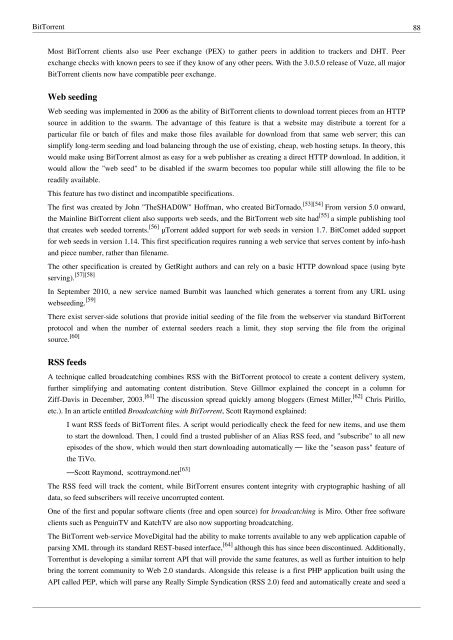Internet Protocol - Research by Kirils Solovjovs
Internet Protocol - Research by Kirils Solovjovs
Internet Protocol - Research by Kirils Solovjovs
You also want an ePaper? Increase the reach of your titles
YUMPU automatically turns print PDFs into web optimized ePapers that Google loves.
BitTorrent 88<br />
Most BitTorrent clients also use Peer exchange (PEX) to gather peers in addition to trackers and DHT. Peer<br />
exchange checks with known peers to see if they know of any other peers. With the 3.0.5.0 release of Vuze, all major<br />
BitTorrent clients now have compatible peer exchange.<br />
Web seeding<br />
Web seeding was implemented in 2006 as the ability of BitTorrent clients to download torrent pieces from an HTTP<br />
source in addition to the swarm. The advantage of this feature is that a website may distribute a torrent for a<br />
particular file or batch of files and make those files available for download from that same web server; this can<br />
simplify long-term seeding and load balancing through the use of existing, cheap, web hosting setups. In theory, this<br />
would make using BitTorrent almost as easy for a web publisher as creating a direct HTTP download. In addition, it<br />
would allow the "web seed" to be disabled if the swarm becomes too popular while still allowing the file to be<br />
readily available.<br />
This feature has two distinct and incompatible specifications.<br />
The first was created <strong>by</strong> John "TheSHAD0W" Hoffman, who created BitTornado. [53][54] From version 5.0 onward,<br />
the Mainline BitTorrent client also supports web seeds, and the BitTorrent web site had [55] a simple publishing tool<br />
that creates web seeded torrents. [56] µTorrent added support for web seeds in version 1.7. BitComet added support<br />
for web seeds in version 1.14. This first specification requires running a web service that serves content <strong>by</strong> info-hash<br />
and piece number, rather than filename.<br />
The other specification is created <strong>by</strong> GetRight authors and can rely on a basic HTTP download space (using <strong>by</strong>te<br />
serving). [57][58]<br />
In September 2010, a new service named Burnbit was launched which generates a torrent from any URL using<br />
webseeding. [59]<br />
There exist server-side solutions that provide initial seeding of the file from the webserver via standard BitTorrent<br />
protocol and when the number of external seeders reach a limit, they stop serving the file from the original<br />
source. [60]<br />
RSS feeds<br />
A technique called broadcatching combines RSS with the BitTorrent protocol to create a content delivery system,<br />
further simplifying and automating content distribution. Steve Gillmor explained the concept in a column for<br />
Ziff-Davis in December, 2003. [61] The discussion spread quickly among bloggers (Ernest Miller, [62] Chris Pirillo,<br />
etc.). In an article entitled Broadcatching with BitTorrent, Scott Raymond explained:<br />
I want RSS feeds of BitTorrent files. A script would periodically check the feed for new items, and use them<br />
to start the download. Then, I could find a trusted publisher of an Alias RSS feed, and "subscribe" to all new<br />
episodes of the show, which would then start downloading automatically — like the "season pass" feature of<br />
the TiVo.<br />
—Scott Raymond, scottraymond.net [63]<br />
The RSS feed will track the content, while BitTorrent ensures content integrity with cryptographic hashing of all<br />
data, so feed subscribers will receive uncorrupted content.<br />
One of the first and popular software clients (free and open source) for broadcatching is Miro. Other free software<br />
clients such as PenguinTV and KatchTV are also now supporting broadcatching.<br />
The BitTorrent web-service MoveDigital had the ability to make torrents available to any web application capable of<br />
parsing XML through its standard REST-based interface, [64] although this has since been discontinued. Additionally,<br />
Torrenthut is developing a similar torrent API that will provide the same features, as well as further intuition to help<br />
bring the torrent community to Web 2.0 standards. Alongside this release is a first PHP application built using the<br />
API called PEP, which will parse any Really Simple Syndication (RSS 2.0) feed and automatically create and seed a


